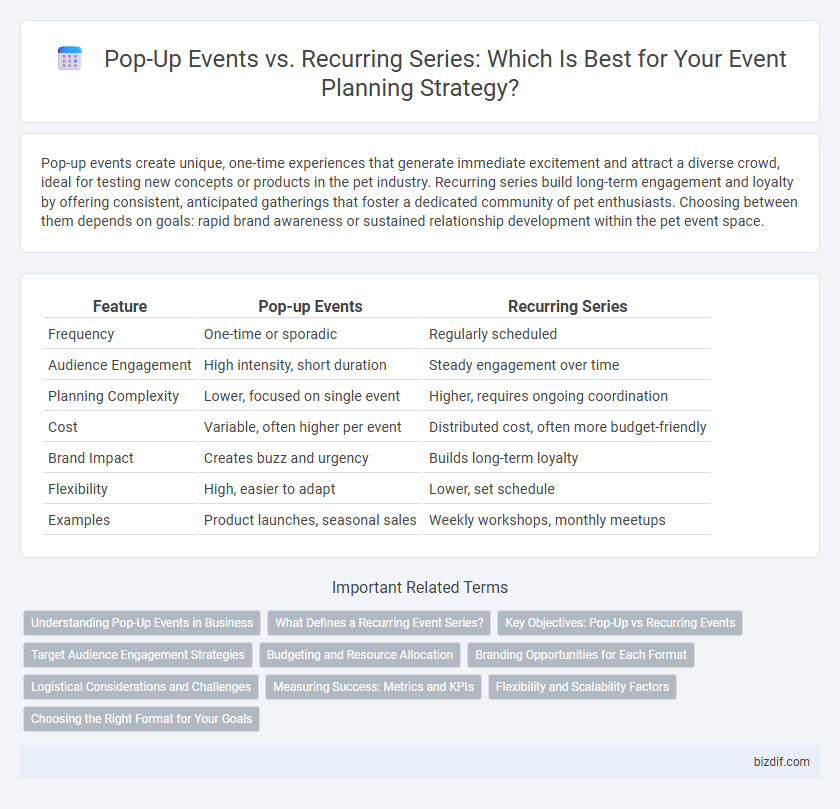Pop-up events create unique, one-time experiences that generate immediate excitement and attract a diverse crowd, ideal for testing new concepts or products in the pet industry. Recurring series build long-term engagement and loyalty by offering consistent, anticipated gatherings that foster a dedicated community of pet enthusiasts. Choosing between them depends on goals: rapid brand awareness or sustained relationship development within the pet event space.
Table of Comparison
| Feature | Pop-up Events | Recurring Series |
|---|---|---|
| Frequency | One-time or sporadic | Regularly scheduled |
| Audience Engagement | High intensity, short duration | Steady engagement over time |
| Planning Complexity | Lower, focused on single event | Higher, requires ongoing coordination |
| Cost | Variable, often higher per event | Distributed cost, often more budget-friendly |
| Brand Impact | Creates buzz and urgency | Builds long-term loyalty |
| Flexibility | High, easier to adapt | Lower, set schedule |
| Examples | Product launches, seasonal sales | Weekly workshops, monthly meetups |
Understanding Pop-Up Events in Business
Pop-up events offer businesses a unique opportunity to create exclusive, time-limited experiences that generate buzz and attract targeted audiences without long-term commitments. These events provide flexibility for testing new markets, launching products, or increasing brand visibility in specific locations, leveraging scarcity to drive customer urgency. Compared to recurring series, pop-up events require less operational investment while delivering high-impact, concentrated engagement that can inform future event strategies.
What Defines a Recurring Event Series?
A recurring event series is defined by its regular, scheduled occurrences that create consistent engagement opportunities and build audience loyalty over time. These events often follow a predictable pattern, such as weekly workshops, monthly networking meetups, or annual conferences, enabling streamlined planning and sustained promotion strategies. Establishing a recurring series helps brands maintain visibility and foster community by delivering ongoing value through repeated interactions.
Key Objectives: Pop-Up vs Recurring Events
Pop-up events maximize brand exposure and create urgency through limited-time experiences, ideal for product launches and testing new markets. Recurring event series build sustained audience engagement, foster community loyalty, and generate predictable revenue streams over time. Selecting between the two depends on whether the key objective is immediate impact or long-term relationship building.
Target Audience Engagement Strategies
Pop-up events create urgency and exclusivity, effectively capturing the attention of target audiences through limited-time engagement and unique experiences. Recurring series build long-term loyalty by consistently reinforcing brand presence and fostering community connections with regular, anticipated interactions. Tailoring marketing efforts to each format's engagement style maximizes audience retention and strengthens customer relationships.
Budgeting and Resource Allocation
Pop-up events require a flexible budget with a focus on one-time expenses and rapid resource deployment, often demanding higher upfront costs for venue, marketing, and staffing. Recurring series enable more predictable budgeting through economies of scale, allowing for optimized resource allocation and cost savings over time by reusing venues, vendors, and marketing materials. Efficient allocation of staff and materials in recurring events reduces variable costs, while pop-ups need contingency funds to manage unexpected expenses and fluctuating audience sizes.
Branding Opportunities for Each Format
Pop-up events create high-impact, short-term branding opportunities by generating buzz and exclusivity that drive immediate consumer engagement. Recurring series offer sustained brand visibility and loyalty through consistent presence, enabling deeper audience relationships and reinforcement of brand identity over time. Choosing between formats depends on whether the goal is rapid awareness or long-term brand building.
Logistical Considerations and Challenges
Pop-up events require intensive coordination for one-time setups, often involving temporary permits, limited venue availability, and quick turnaround times that challenge supply chain and staffing flexibility. Recurring series benefit from established routines, allowing streamlined logistics with predictable resource allocation, yet face the ongoing challenge of maintaining consistent attendee engagement and adapting to evolving venue constraints. Managing inventory, transportation, and staffing scalability are critical for both formats but demand different strategic approaches to ensure operational efficiency and event success.
Measuring Success: Metrics and KPIs
Tracking attendance rates, engagement levels, and social media reach provides critical insights into the success of both pop-up events and recurring series. Pop-up events typically emphasize immediate impact metrics like foot traffic and on-site conversions, while recurring series benefit from longitudinal KPIs such as customer retention, frequency of attendance, and lifetime value. Leveraging data analytics tools to monitor these metrics enables event planners to optimize strategies and demonstrate ROI effectively.
Flexibility and Scalability Factors
Pop-up events offer exceptional flexibility by allowing planners to test different locations, themes, and audiences without long-term commitments, making them ideal for market experimentation. Recurring series prioritize scalability, enabling event organizers to build brand loyalty and streamline operations through consistent scheduling and audience engagement. Balancing these factors helps businesses optimize resource allocation and maximize impact across diverse event formats.
Choosing the Right Format for Your Goals
Pop-up events create urgency and excitement, ideal for brand launches or testing new markets, while recurring series build loyal audiences through consistent engagement and long-term relationship development. Consider your objectives--if immediate impact and buzz are priorities, a pop-up format suits your goals, whereas recurring events support sustained exposure and community growth. Align event format with marketing strategy, budget constraints, and audience behavior to maximize return on investment.
Pop-up events vs recurring series Infographic

 bizdif.com
bizdif.com